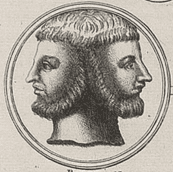Alma uses the verb “spring” in an interesting way in his sermon to the Zoramites in Alma 32 and 33:
But if ye will nourish the word, yea, nourish the tree as it beginneth to grow, by your faith with great diligence, and with patience, looking forward to the fruit thereof, it shall take root; and behold it shall be a tree springing up unto everlasting life. (Alma 32:41)
And now, my brethren, I desire that ye shall plant this word in your hearts, and as it beginneth to swell even so nourish it by your faith. And behold, it will become a tree, springing up in you unto everlasting life. And then may God grant unto you that your burdens may be light, through the joy of his Son. And even all this can ye do if ye will. Amen.(Alma 33:23)
Others have noted the intriguing reference to tree of life symbolism here, drawing upon themes in the ancient Near East, not to mention related themes in Mesoamerica. But here I wish to consider the possibility of a potential word play or poetical device in the form of a Janus parallelism.
Janus parallelism refers to the two-headed Roman god, Janus, who could look forward as well as backward. In Janus parallelism, one word or phrase serves in two parallel structures by also looking both forward and backward, relying on a double meaning to connect in both directions to nearby words or phrases. Over at Interpreter: A Journal of Latter-day Saint Faith and Scholarship, I once reviewed Scott Noegel’s excellent book on the abundant use of Janus parallelism in Job and also tentatively proposed several possible examples of Janus parallelism in the Book of Mormon based on the presumed Hebrew words behind the English translation. More recently Paul Hoskisson has proposed a possible example of Janus parallelism in 1 Nephi 18:16. By the way, I find it interesting that most of the examples with potential Janus parallelism come from Nephi, the man closest to the deep details of Hebrew poetry. In fact, chiasmic structures and parallelism in general is not distributed uniformly or randomly in the Book of Mormon, but has a distribution that is consistent with the details of the book’s claimed ancient origins as opposed to being the fruit of Joseph Smith’s mind. On the fascinating distribution of parallelism among Book of Mormon texts, see Carl J. Cranney’s analysis in “The Deliberate Use of Hebrew Parallelisms in the Book of Mormon,” Journal of Book of Mormon Studies 23 (2014):140–65.
Getting back to the verses from Alma, in English, readers may note that “spring up” naturally relates to the sprouting, growth, and flourishing of the tree that is nourished in the first portion of both verses. But “springing” and “everlasting life” seem less related. I have previously felt it was a somewhat odd word choice for discussing entry into eternal life, though it does convey a dynamic, vibrant sense that relates well to the tree. Recently I wondered if considering possible Hebrew roots behind this word might be useful.
The Hebrew word for “spring” can be Strong’s H6779, tsamach, to sprout or spring up. This can refer to plants, hair, and figuratively to speech, and can also mean to grow abundantly or thickly, or to cause to grow. This is translated 13 times as “grow” in the Old Testament, “spring forth” six times, “spring up” four times, and twice each for “grow up,” “bring forth,” “bud,” and “spring out.”
Strong’s H6523, parach, can mean to bud, to sprout, to bloom, to blossom or send out shoots, as well as to break out (for leprosy) and to fly. It is most commonly translated as “flourish” (10 times), followed by “bud” (5 times), “blossom” (4 times), etc., with “spring” occurring twice and “spring up” occurring just once.
More interesting might be Strong’s H5927, ‘alah, which can mean to ascend or climb, as in to spring up or grow for vegetation, or to come up (before God), to go up, to excel, to be superior, and even to be exalted. This combination of meanings, the vegetative springing up of a plant but also the rising up to exaltation or coming up before God could make this an ideal word to use in Alma 32.
By using ‘alah or a related word that can both reflect the climbing or growing of a tree as well as being exalted or coming up into the presence of God, then both Alma 32:41 and Alma 33:23 could function as a Janus parallelism in which that word does double duty, creating a parallel with the preceding portion of the verse related to the growth of a tree while also creating a parallel related to entering into eternal life in the final portion of the verse based on an additional meaning related to exaltation or coming up before God.
This is a tentative proposal that has not been subject to peer review. As always, I may be completely wrong and, as always, I welcome your relatively civil feedback on this topic.












If I may, Jeff, I'd like to offer some relatively civil feedback:
1. It would obviously help to know whether the original text uses the word tsamach, parach, 'alah, or something else. It would be nice to know if any of those words exist in Reformed Egyptian, or whether Reformed Egyptian exists at all. It would be nice to know whether there even is an original text.
The point I am very civilly trying to make is that you're engaging in speculation on speculation on speculation. You're relying on questionable assumption after questionable assumption after questionable assumption.
One might as well ask whether, in the original text of the Book of the Battle of the Dragon and the Unicorn, the Martian steel of the unicorn's horn can actually withstand the Romulan fire of the dragon's breath.
2. Have you considered the possibility that Joseph Smith was adapting the KJV's rendering of John 4:14, which links the term springing to the concept of eternal life? ("But whosoever drinketh of the water that I shall give him shall never thirst; but the water that I shall give him shall be in him a well of water springing up into everlasting life.") Given that we actually know the KJV exists, and that Joseph Smith was quite familiar with it, this possibility would seem much more amenable to genuinely scholarly analysis (as opposed to hopelessly speculative apologetics).
3. Remember the Alamo! Oops, I meant Remember the Texas Sharpshooter! When you go looking for correlations between items in two very large datasets — between terms in the Book of Mormon and the full range of denotations and connotations in the ancient Hebrew lexicon — you are highly likely to find "hits" entirely by chance. I'm still not sure you really understand this core methodological problem.
Anyway, Happy New Year everyone!
— OK
“You're relying on questionable assumption after questionable assumption after questionable assumption.“
This is a decent description of most Mormon apologetics. No matter how many times this is pointed out to Jeff, he prefers playing around in his fantasy world free of academic accountability.
Anachronism wrapped around parallelism is to me a poor way to build support for the Book of Mormon. If it is an ancient Hebrew/modified Egyptian/precolumbian American text then your argument actually means it isn’t from those backgrounds but a 19th century document.
Jeff’s article here obviously isn’t an apologetic endeavor. His intended audience is believers in the Book of Mormon rather than skeptics. Consequently, it goes way over the heads of the anonymous commenters. In this instance, Jeff begins with the assumption that the Book of Mormon is what it claims to be—a translated document with origins in the Hebrew language. That will invariably flummox unbelievers, who respond with invalid observations such as: “It would be nice to know if any of those words exist in Reformed Egyptian…” (Since Egyptian was ideographic rather than phonetic, it would have clearly existed in a Hebrew’s rendition written in Egyptian—for the same reason that spoken Cantonese and Mandarin share the same written characters but different languages.) Add to that the fact that Moroni designates his script “Reformed Egyptian” more than a thousand years removed from Lehi and 500 years from Alma, an appeal to Reformed Egyptian is a red herring—but he notes he could have written in Hebrew had he wanted to.
If Jeff’s premise above were, “Janus Parallelism is evidence for the veracity of the Book of Mormon” the critics above might have a point; but his premise begins way beyond that for an audience that shares his perspective.
Alma, even if we accept that Jeff's only aim here is to consider "the possibility of a potential word play or poetical device in the form of a Janus parallelism," and that his intended audience is limited to those who already believe, my suggestions would seem to be just as relevant. If his aim is the edification of believers, why would he want them thinking something is a wordplay if in fact it's just an artifact of a faulty methodology? Why would he want them thinking something is true when in fact, because of the lack of original text in the original language, he has no idea whether it's true or not?
You seem to be suggesting that sound scholarship is necessary when addressing skeptics, but that when addressing believers, any old sloppy speculation will do.
But don't believers deserve better than that?
— OK